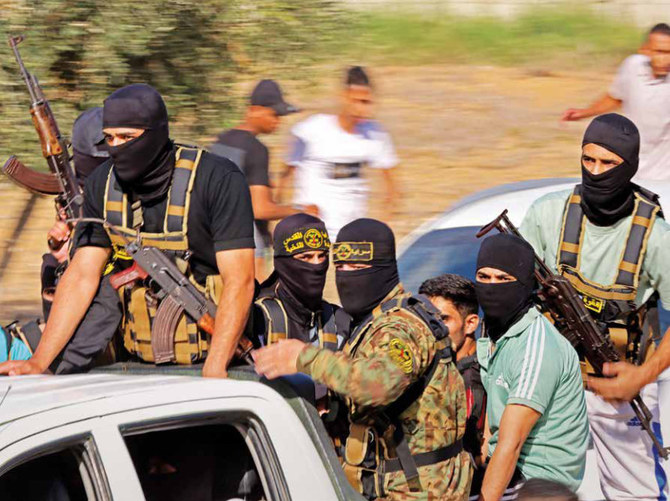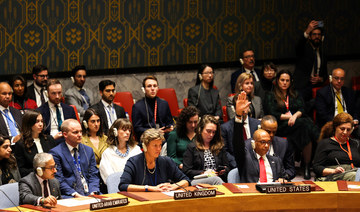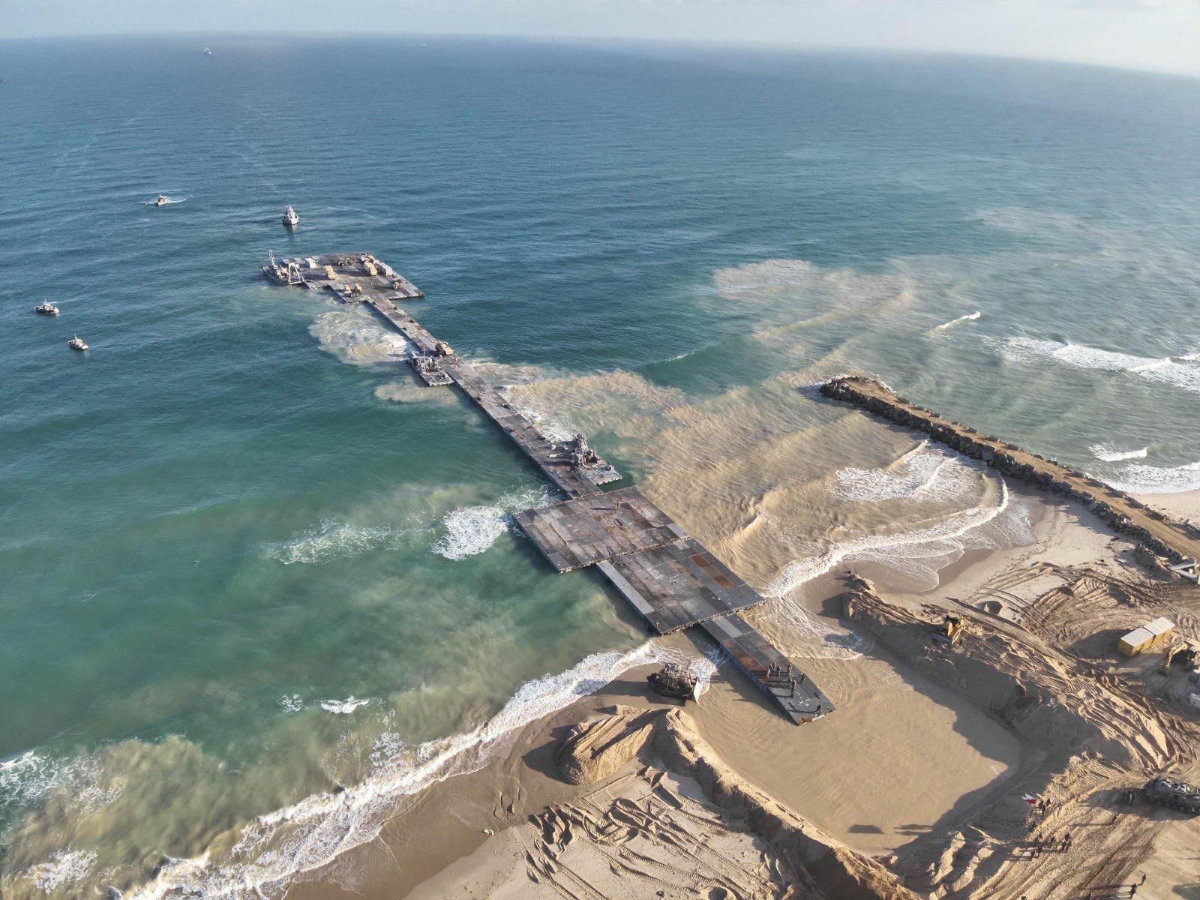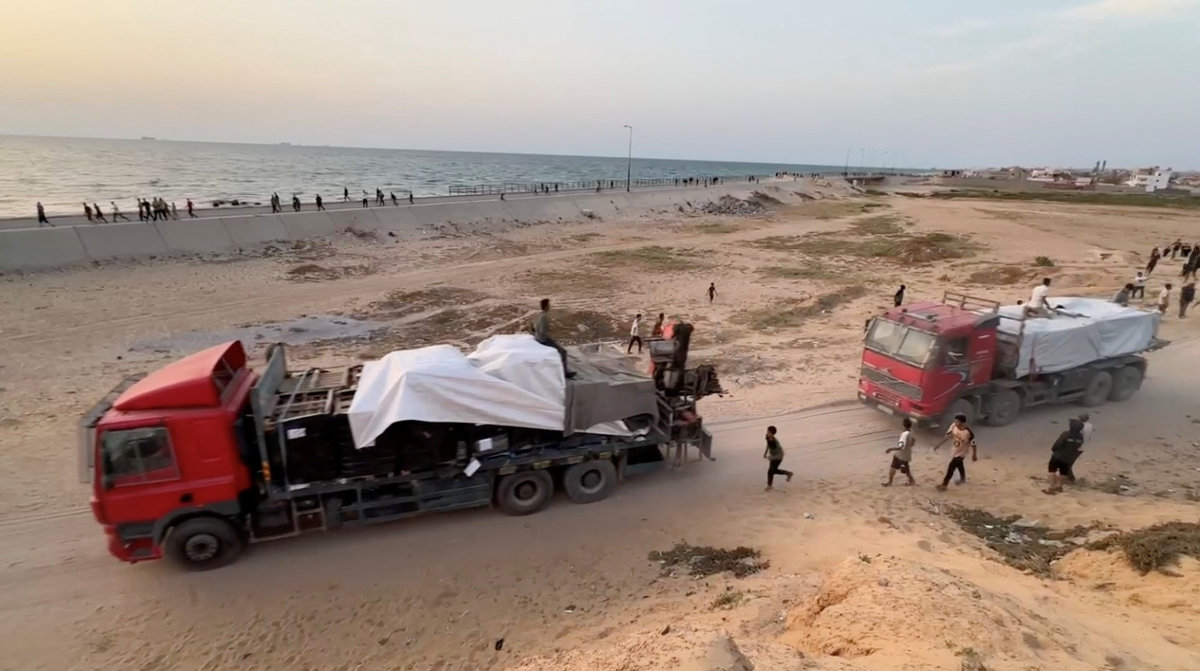LONDON: On Oct. 6, 1973, Israel was taken completely unawares by an attack by a coalition of Middle East states, led by Egypt, that came very close to wiping it off the map.
In the end Israel, backed by a massive airlift of advanced weaponry and other support from the US, survived the Yom Kippur War, albeit at great cost — more than 2,600 of its soldiers were killed, and thousands more wounded.
But “it was a massive intelligence failure,” said Ahron Bregman, a UK-based Israeli historian, author and political scientist.

Palestinians take control of an Israeli Merkava battle tank after crossing the border fence with Israel from Khan Yunis in the southern Gaza Strip on October 7, 2023. (AFP/File)
Afterward, in a society left “in a state of deep collective shock,” hard questions were asked of Israel’s politicians, the military and the intelligence community and, “supposedly, lessons were learnt.”
But almost exactly 50 years later to the day, on Oct. 7, 2023, Israel was taken by surprise once again, this time by a Hamas assault that left at least 1,200 Israeli citizens and soldiers dead, and saw almost 250 carried back into Gaza as hostages.
Now, in an Israel wracked and divided by self-doubt, anxiety and anger at the failure of its government and much-vaunted military forces not only to anticipate and prevent the attack, but also to respond to it in a timely fashion, hard questions are being asked once again about what went wrong, and who is to blame.

Hamas militant seize Israeli hostages in Kibbutz Be'eri during a massive attack against the Jewish state on October 7, 2023. (X photo)
“Like in the Yom Kippur War, the Israelis had all the information in front of them — everything, all the details,” said Bregman, a senior teaching fellow in the Department of War Studies at the UK’s King’s College London, who served in the Israeli army for six years.
“This was another massive intelligence failure on the part of the Israelis.
“In the future, the Hamas attack on the seventh of October will be taught in military schools, alongside Pearl Harbor, Operation Barbarossa (Germany’s surprise attack on Russia in 1941) — and the Yom Kippur War.”
 Thanks to a startling leak, presumably from within Israel’s intelligence community, it is clear that the failure in the run-up to Oct. 7 was all the more remarkable because Israel had acquired a copy of Hamas’ battle plan prior to the attack.
Thanks to a startling leak, presumably from within Israel’s intelligence community, it is clear that the failure in the run-up to Oct. 7 was all the more remarkable because Israel had acquired a copy of Hamas’ battle plan prior to the attack.
On Nov. 30 The New York Times ran an exclusive story claiming that Israeli officials had obtained the plan “more than a year before it happened ... But Israeli military and intelligence officials dismissed the plan as aspirational, considering it too difficult for Hamas to carry out.”
Hamas had “followed the blueprint with shocking precision” and, concluded The Times, “what could have been an intelligence coup turned into one of the worst miscalculations in Israel’s 75-year history.”
Disenchanted intelligence operatives are not the only Israelis coming forward with revelations about Israel’s failings leading up to Oct. 7.
Evidence is now emerging that in the months, weeks and days leading up to the Hamas attack repeated warnings by Israeli army observers tasked with monitoring the “Iron Wall” between Israel and Gaza were ignored or dismissed.
Video feeds from cameras along the length of the high-tech fence, which in 2021 was given a $1 billion upgrade, are monitored day and night by members of the Israel Defense Forces’ Combat Intelligence Collection Corps.
The wall seemed formidable: a 6-meter-tall fence, topped with razor wire and embedded in deep concrete foundations to foil tunnelling, bristling with sophisticated surveillance systems and remote-controlled machine guns mounted on towers along its length.
But on Oct. 7, the high-tech wall was defeated by a combination of low-tech bulldozers, explosives and drones that dropped bombs into the machinegun nests.
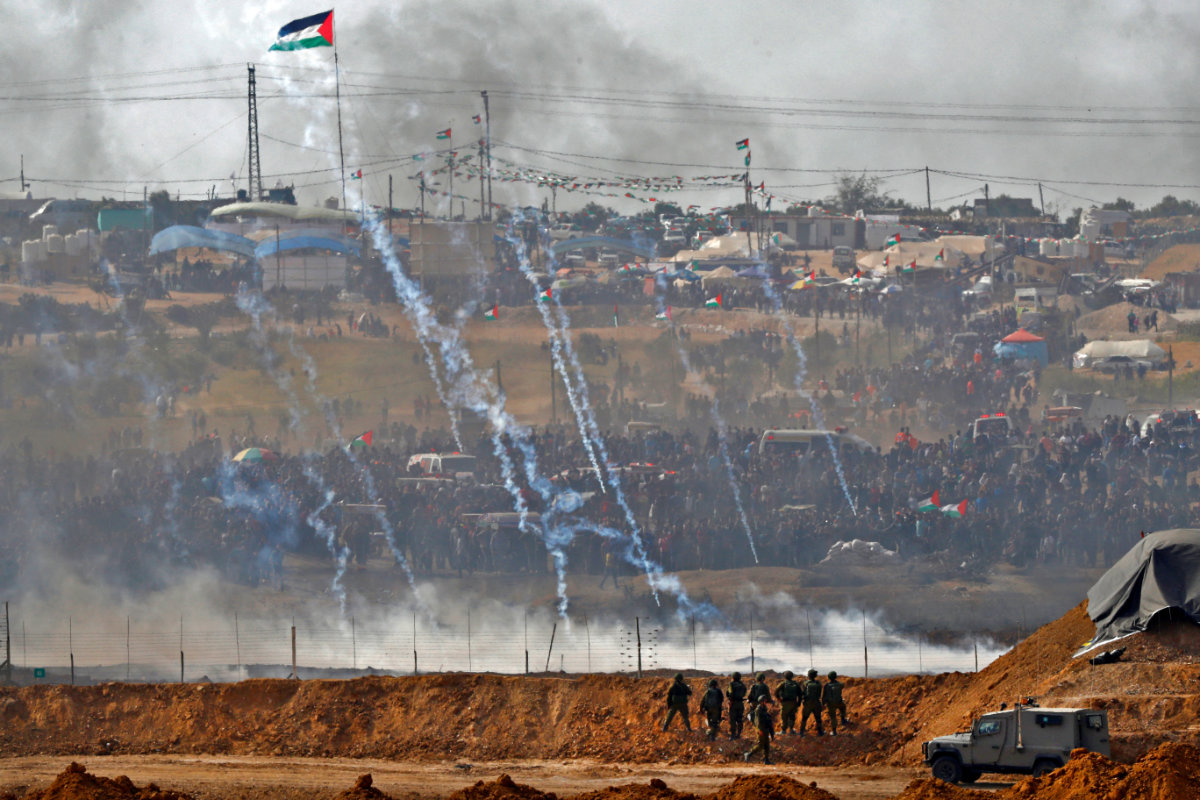
In this picture taken on April 13, 2018, Israeli soldiers keeping position in the southern kibbutz of Nahal Oz across the border with the Gaza Strip as Palestinian protesters gather along the border fence. Hamas militants easily defeated the high-tech wall in a massive attack on Oct. 7. (AFP/File)
One of the first targets of the Hamas fighters who poured through the breached fence was a military base at the kibbutz of Nahal Oz, about 1 kilometer inside Israel. There, 25 of the 27 female observers were killed.
As Israelis look for answers to explain why the Hamas attack was so successful, and the Israeli military’s response so inadequate, the two women who survived the attack on the base have now come forward with allegations that repeated warnings given by them and their colleagues were brushed aside by superior officers.
According to a report in The Times of Israel, for at least three months before the attack the observers spotted and reported repeated and increasingly suspicious activities, including “Hamas operatives conducting training sessions multiple times a day, digging holes and placing explosives along the border.”
Yet all these signs were “disregarded as unimportant by intelligence officials.”
One of the two survivors from Nahal Oz told Israel’s Kan public broadcaster that she had watched Hamas operatives training at the border fence for weeks.

Palestinians drive an Israeli tractor that was seized after crossing the border fence with Israel from Khan Yunis in the southern Gaza Strip on October 7, 2023. (AFP/File)
Maya Desiatnik realized it was “just a matter of time” before something big happened, but her repeated warnings were ignored. And on Oct. 7 something big did happen.
She began her shift that day at 3:30 a.m. All was quiet at first, but at 6:30 a.m. “we saw people running to the border from every direction, running with guns,” she told Kan. “We saw motorbikes and pickup trucks driving straight at the fence.
“We watched them blow up the fence and destroy it. And we might have been crying but we continued to do our jobs at the same time.”
But the expected support from rapid-response troops, summoned as per protocol, did not materialize.
“It’s infuriating,” Desiatnik told Kan. “We saw what was happening, we told them about it, and we were the ones who were murdered.”
Israel makes much of the fact that women serve alongside men in its armed forces. With certain exceptions, every Jewish, Druze or Circassian citizen over the age of 18 does compulsory military service.

Israeli soldiers patrol along to the border fence of Kibutz Beeri near the border with Gaza Strip on October 25, 2023, in the aftermath of the October 7 attack by Palestinian Hamas militants. (AFP/File)
Men are expected to serve for at least 32 months and women, who frequently feature in IDF videos, for a minimum of 24.
But one explanation for the failures on Oct. 7, said Bregman, “is in my view to do with gender.”
“Most of the observers along the border, who follow and report on Hamas activities, are women soldiers,” he said.
“Yet in the weeks and months leading up to Oct. 7, they kept reporting to their superiors, all of whom were men, of course, saying ‘Look, they are preparing an attack on us, here is all the information,’ and they were dismissed.
“And I believe that one of the reasons why they were dismissed was the fact that they were young women.”
But the military’s deadly lack of confidence in its female observers was just one of several failings that contributed to the disaster on Oct. 7, Bregman says, including “the very existence of the fence.

Ahron Bregman
“There is a psychological dimension here. You think ‘Well, I’ve got a fence, I am protected,’ and then you start cutting corners, thinking you don’t need so many troops in this area.
“On Oct. 7 yes, there was a very sophisticated fence, like nothing else anywhere in the world. But there was nobody to protect it, because most of the troops were elsewhere, in the West Bank.”
In his view, Benjamin Netanyahu, Israel’s prime minister, also has a lot to answer for.
“Netanyahu believed that if you could just feed Hamas with money and jobs in Israel, it would keep quiet. The belief in Israel was that Hamas was deterred from going to war, but that belief was in Israeli heads, and not in Hamas’.
“Netanyahu wanted to believe that Hamas would not go to war, and this idea filtered down to the military itself, and they ended up believing it.”
Inevitably, social media is abuzz with conspiracy theories about Oct. 7, including that the Israeli government knew about the impending attack but let it happen, in order to justify a wholesale assault on Gaza.
The slow response by Israel’s military to the attack is attributed to a claim, accompanied by the hashtag #BibiKnew, that Netanyahu ordered the IDF to stand down on the day.

Israel’s prime minister, Benjamin Netanyahu, "wanted to believe that Hamas would not go to war, and this idea filtered down to the military itself, and they ended up believing it,” says UK-based Israeli historian Ahron Bregman. (AFP/File)
“But I think we have too many solid explanations for this intelligence failure to start believing in conspiracy theories,” said Bregman.
“It was not in Netanyahu’s interests to go to war. His entire strategy was to have Hamas in power so he did not have to do the two-state solution.”
The success of the attack was not due entirely to Israeli failings.
“If you look back at the military history of Hamas, you can see that it is a very adaptable organization, and the Israelis failed to realize this,” said Bregman.
It is also clear that, in the words of “a source close to Hamas,” speaking to Reuters, “Hamas used an unprecedented intelligence tactic to mislead Israel over the last months, by giving a public impression that it was not willing to go into a fight or confrontation with Israel while preparing for this massive operation.”
As part of this subterfuge, Hamas had refrained from attacking Israel for two years, and created the impression that “it cared more about ensuring that workers in Gaza ... had access to jobs across the border and had no interest in starting a new war.”

Palestinians watch rescue workers as they search for the bodies of three Hamas militants inside a tunnel targeted by an Israeli air strike, near the border between Israel and Khan Younis in the southern Gaza Strip, on November 2, 2013. (AFP/File)
Yossi Mekelberg, professor of international relations and an associate fellow of the MENA Program at UK-based international affairs think tank Chatham House, has no doubt that there will be a full accounting for the disaster of Oct. 7 when the fighting finally stops.
“There are rumors and leaks and although it’s clear that there was a systemic failure, until we hear evidence under oath in an investigation it’s difficult to know exactly what happened,” he said.
“But there must be an inquiry, there is no other option. When the war is over, and a lot of reservists are discharged, they will be the first to demand an inquiry, the families of those who were killed on Oct. 7, the families of those who were taken hostage, the families of the soldiers that were killed since Oct. 7, they will all relentlessly demand an inquiry, and rightly so.”
He is hesitant to predict the political outcome of the disaster for Netanyahu and his right-wing Likud party: “Who knows, in politics, but I will be very surprised if he’s not done.”

Major General Aharon Haliva, head of the IDF’s military intelligence directorate, along with the head of the Shin Bet security agency and IDF chief of staff, has acknowledged full responsibility for the deadly Hamas attack. (Supplied)
Fifty years on from Yom Kippur, Israel is once again in a state of “deep collective shock.”
Yet ultimately, amid domestic dismay at Israel’s failings before, during and after Oct. 7, and growing concern at home and abroad at the IDF’s disproportionate meting out of death and destruction in Gaza, it may be the Israeli response rather than the Hamas attack itself that proves to be a tipping point in the seemingly endless cycle of violence.
“I really think we are at a junction here,” said Mekelberg.
“I would like to see people draw the conclusion that conflict and bloodshed achieve nothing, but add to the anger and the bitterness and the need for revenge, and that this needs to change.
“What is needed now is different leadership, that will create some hope, and there could be a much better future for both Israel and Palestinians — and I think the potential is endless.”






